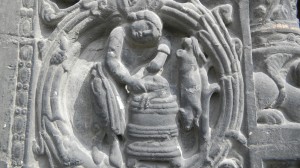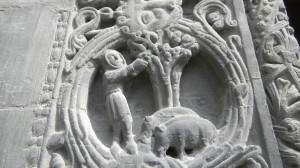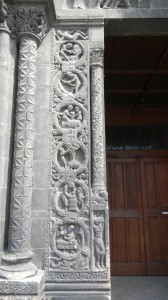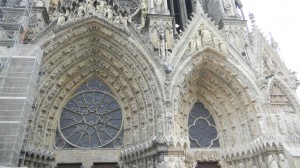Back to work!
Gothic cathedrals and basilicas gave working stiffs like us an honored place on their outer walls. But folks in the 13th century conceived occupations in a different way.
They saw things, less as independent entities than modern Westerners have, and more as parts of a larger system of the universe.
These different labors were thus seen according to a mathematical system: the 12 months of the year. Each month had its characteristic work, such as sowing and harvesting.
So each side of the south portal of the Basilica of St. Denis has 6 labors. But the number 12 was very sacred, and it had other meanings.
Emile Male, in his classic book, The Gothic Image, wrote that folks in the 13th century saw symmetry as an expression of divine harmony. Thus it was no accident that there were also 12 patriarchs, 12 prophets of the Ancient Law, and 12 apostles of the New Law. 12 is the product of 3 and 4. Three is the number of the Trinity, and Plato said that the soul has 3 components. 4 is the number of elements. So 12 links the spiritual and material worlds, and the Old Testament and the New Testament. It’s thus natural that the rhythms of nature’s months and humanity’s labors echo this divine order. All domains reflect each other.
Male wrote that medieval folks found 7 the most captivating number. It’s the sum of 3 and 4, and thus it also unifies the spiritual and material worlds. There are 7 planets, 7 sacraments, and 7 stages of human life, and each stage has its own virtue. Universities taught 7 liberal arts. Cathedral makers personified the virtues and liberal arts, and sculpted them over the entrances (like at Rheims above, where you can see 3 paired rows of beings forming an arch over the narrative scenes–7 grace the middle row). There were also 7 tones in the Gregorian musical scale.
Scholars found all sorts of numerical values in the Bible. Gideon traveled with 300 companions because in Ancient Greek, 300 was written as the letter tau (T). The letter T is in the form of the cross. So Gideon prefigured the life of Jesus. Many other Old Testament stories did too.
In the same way, all those sets of 7 mirrored the 7 days of creation which the Bible describes. We thus see another beautiful example of a matching set of 7 figures over Laon Cathedral’s main entrance (above).
9 was another especially sacred number. It’s not only 3 squared, it’s also the number of types of heavenly beings. We saw some gnarly dudes in The Life In Gothic Style, Part One. They were monstrous creatures in the bottom levels of God’s hierarchy of creation. Medieval folks also imagined many levels above us in a spiritual hierarchy: Seraphim, Cherubim, Thrones, Dominions, Virtues, Principalities, Powers, Archangels and Angels.
The above shot brings us from the lower beasts outside of Rouen Cathedral to the divine order inside of it. The Gothic cathedral expressed folks’ ideas of a sacred order which all the diverse beings exist within. This order is very Western–it’s symmetrical and linear. As you can see in Gothic logic, the segments in cathedrals like Rouen are logically related, and they proceed in a line towards Christ.
Art that Cambodians and Indians made at the same time didn’t stress this much linearity and logical clarity. Their art reflected the exuberance of their tropical climates. The Gothic cathedral builders also represented a spiritual universe, but they used thought patterns well established in the ancient West to order it.
This is a real cool thing about cultural studies–you can see patterns from cultures’ ancient pasts, and they take on new variations as times change. When you compare different cultures, they shine on each other as gloriously as Gothic stained glass windows. The heavenly beauty that their builders dreamed of is right here in the world. Share it with your kids.








Comments on this entry are closed.